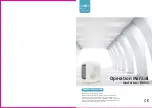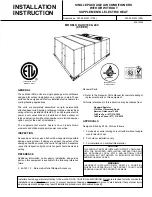
58
9. Test Run
Perform trial run according to Chapter 9.2. Record the values as per Table 9.1.
CAUTION
!
●
Start the machine only when all the check points are checked and cleared.
For indoor unit
test run, refer to the installation manual and which is attached to the indoor unit.
9.1 Prerequisites for Test Run
1. Ensure that the indoor and outdoor refrigerant pipe and communication wires are connected to
the same refrigeration system. Otherwise, it leads to abnormal and serious accidents. Check the
refrigerant system no. for indoor/outdoor units (DSW1 and RSW1 [outdoor unit], DSW5 and RSW2
[indoor unit]) and indoor unit number (RSW). Make sure that the DIP switch on the base board of
the indoor and outdoor unit is set correctly. In particular, pay attention to the indoor and outdoor unit
height difference, refrigerant system number setting and terminal resistance setting. Refer to wiring
diagram in chapter 7 for more details.
2. Ensure that the terminal resistance to ground exceeds 1MΩ, Otherwise, find out the earth leakage
point and fix it before starting the system. Do not apply strong electricity to the communication
terminals (outdoor unit: TB2 1.2.3.4 / indoor unit:TB2 1.2.A.B).
3. Ensure that the power wire L1, L2, L3 and N are connected correctly.
4. The power supply is connected for 12 hours or more to ensure that the crank case heating the
compressor oil.
After the power is turned on, if the compressor oil temperature is low, the units do not run immediately
(stop code d1-22) .
If starting operation within 2hours of power on, follow the steps below to lift the protection:
1. Turn on the power to the outdoor unit.
2. Wait for 30 seconds.
3. Press and hold the PSW5 button on the outdoor unit for more than 3 seconds to release the
protection code d1-22.
5. Identification of master unit
With the combination of base modules, to easily distinguish the master unit A, paste an identification
label on an apparent location on the master unit (Outdoor unit A). Do not attach master unit label to
slave unit (Outdoor unit B, C and D).
NOTICE
Insulation resistance precautions
If the total insulation resistance is lesser than 1MΩ, then the compressor insulation resistance can go
low due to the refrigerant remaining in the compressor. This occurs when the machine idle for a long
time.
1. Disconnect the compressor power wire. Measure the insulation resistance of the compressor body.
If the resistance is higher than 1MΩ, the lower insulation resistance is caused by other electrical
components.
2. If the compressor insulation resistance is lesser than 1MΩ,disconnect the inverter cable and then,
turn on the compressor crankcase heating belt and turn on the power.
After 3 hours of powering measure the insulation resistance of the compressor body again. (Duration
of time should be longer to depending on outdoor weather conditions, piping length and refrigerant
status.) Measure the insulation resistance and connect the compressor power wire.If the ELB acts,
check and confirm if the ELB specification meets the recommended specification shown in table 7.1.











































